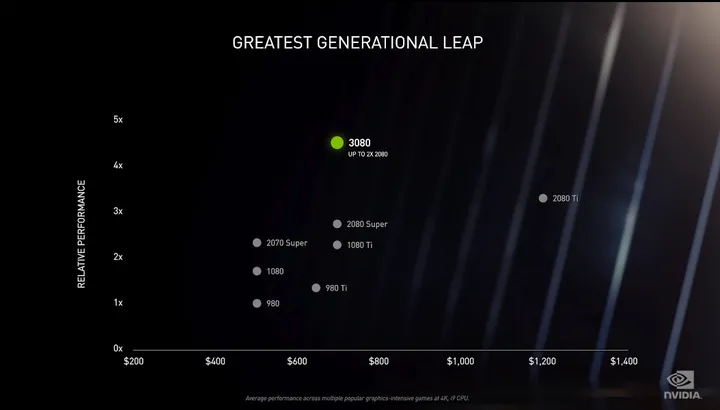Nvidia’s domination of the graphics card industry continues

A few minutes every morning is all you need.
Stay up to date on the world's Headlines and Human Stories. It's fun, it's factual, it's fluff-free.
Nvidia chief executive officer Jensen Huang revealed Nvidia’s latest line of Graphics Processing Units (GPUs) in an online event last week, claiming the company’s latest range would prove to be the “greatest generational leap” for consumers, signaling as well the ongoing innovation of the American semiconductor industry.
Huang revealed the long-awaited RTX 3000 series of GPUs on September 1, promising both significantly increased performance and significantly reduced prices, especially when compared to previous entries in Nvidia’s long line of video card units.
The announcement of Nvidia’s newest GPU range is a direct challenge to rival AMD, who has yet to reveal its own hotly-anticipated next-gen graphics cards.
The announcement also accentuates the health of the GPU industry more broadly. Competition between both Nvidia and AMD for market share of what is a multibillion-dollar industry has clearly helped to instill both technological innovation and competitive pricing in the two rivals.
Although Nvidia’s announcement is primarily welcome news for fans expecting better performance and better mileage for their money in the latest round of computer hardware, it is also good news for the industry as a whole.
Growth and innovation are likely to continue into the future, even as the world deals with the financial constraints of the coronavirus pandemic.
Nvidia’s newest releases are a bold claim to securing even more of the ever-growing industry and continuing the rivalry between the two hardware producers that has so far paid dividends for consumers.
Nvidia’s tech
Nvidia claims that its newest RTX 3000 series of GPUs will see the “greatest generational leap” in its hardware yet. The figures for the new tech certainly seem to back this up.
The announced GPUs so far contain the low-cost RTX 3070, the midrange RTX 3080 and the expensive but incredibly powerful RTX 3090, with the latter launching later this month.

The new components are based on Nvidia’s own “Ampere” technology and the 3080, in particular, is being released at a fraction of the price of Nvidia’s previous flagship card – the 2080 Ti – but with a significantly enhanced performance.
The new RTX 3080 will be released in the United States on September 17 for US$699 and will contain 10GB of GDDR6X memory and new cooling technology to aid performance. The older 2080 Ti is typically priced at over US$1,000, but Nvidia claims the new, cheaper 3080 will significantly improve upon its predecessor’s performance.
Fans of Nvidia products quickly took to reselling their own Ti 2080s online after the announcement.
This will likely mean that the cost of the usually US$1,000+ 2080 Ti cards will see a significant price reduction, making them more accessible to the average consumer.
Alongside the 3080, Nvidia also announced a mammoth-sized (in GPU terms) RTX 3090, priced at US$1,499. Though out of reach for many consumers, the new hardware boasts more than 24GB of GDDR6X memory and hopes to pull the gaming industry into making gaming at 8K resolutions a reality.
According to Bloomberg, Nvidia’s announcement has allowed the company to prove once again “that it is way ahead of its rivals in terms of innovation and performance.”
Thriving industry
Nvidia’s new range of high-performance GPUs marks the latest entry into what is an increasingly profitable business for the company amid a wider industry that is enjoying strong growth.
In a call with investors last month, Nvidia CEO Jensen Huang looked optimistically toward Nvidia’s near future, claiming “this may very well be one of the best gaming seasons ever.”
Huang’s optimism is well-placed and Nvidia’s industry continues to thrive despite the global economic fallout caused by the coronavirus pandemic.
Since December 2019, Nvidia’s shares have grown by 127% and the company appears well on track to reach projected revenues of around US$13 billion by 2021, up from around US$9 billion in 2018.
Nvidia is not just involved in the business of selling its hardware and software to computer gamers and video game console manufacturers, it is increasingly taking on more corporate clients.
Nvidia also sells its GPU hardware for use in data centers that make use of AI software and host cloud services.
For the first time ever, this year has seen Nvidia pull in more revenue from this side-business than its gaming operations.
Competition
Nvidia’s latest round of hardware will not necessarily peg back its closest rival, AMD (Advanced Micro Devices Inc.).
Instead, Nvidia’s new releases are the result of a pattern of recent innovation and competition that has forced both American companies to better deliver products that satisfy consumers.
Nvidia and AMD are the foremost producers of discrete GPUs, deriving billions of dollars from this field. Integrated graphic units, the kind common in many laptops and low-cost desktops, is also dominated by American tech company Intel.
The GPU industry is a serious business. The global GPU market size was estimated at around US$18.2 billion in 2019 and is expected to grow to some US$35.3 billion by 2025. Nvidia earned some US$10.2 billion in revenue over 2019, whereas AMD earned US$4.7 billion and Intel US$3.3 billion.
Prior to Nvidia’s recent announcement of a new line of GPUs, AMD was slowly gaining on its rival. Its Q4 2019 report showed that it had a 22.6% increase in overall GPU shipments in that quarter, chipping away at both the market shares of Intel and Nvidia.
In terms of discrete GPU units, AMD’s shipments increased from 24% in Q3 2019 to 27% of the market total, slowly gaining on Nvidia’s current dominance.
In perspective, the “greatest generational leap” Nvidia has taken with its new releases is a result of an industry that consistently displays growth, even as financial turmoil afflicts many other industries and economies around the world.
Although Nvidia has come out first in revealing its intentions to dominate the next-generation of graphics hardware, AMD’s success in recent years in challenging Nvidia’s dominant market share suggests that the hardware rival will nonetheless put up a challenge.
With details of AMD’s own next-generation GPUs expected this year, the rivalry between the two American tech giants, one that has pushed Nvidia to release a hugely-improved and acceptably-priced range of hardware, seems likely to continue generating benefits for consumers around the world and keep this sector of the American tech industry thriving.
Have a tip or story? Get in touch with our reporters at tips@themilsource.com




Comments ()